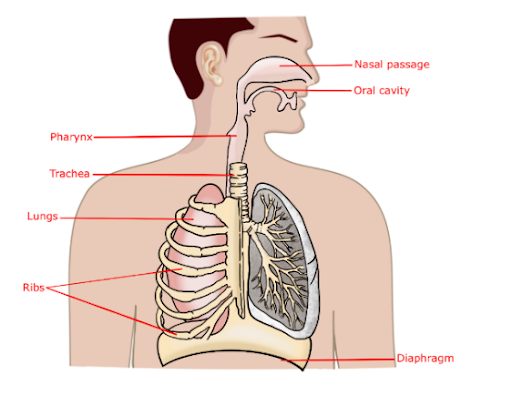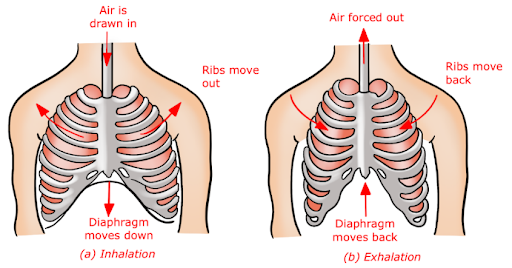The series of events that results in the exchange of oxygen and carbon dioxide between the atmosphere and the body cells is known as respiration. External respiration is the term for this. The gases are transported to and from the tissue cells by the blood. Internal respiration is the exchange of gases between the blood and tissue cells.
To obtain energy from food, all living organisms need respiration. The entire process of breathing is a form of respiration.
Importance of Respiration
- Cells are microscopic units that make up all life. Nutrition, transport, excretion, and reproduction are the processes performed by each cell of an organism
- A cell requires the energy to carry out these processes. Energy is stored in the diet and released during breathing
- Inhaled air is carried to all areas of the body and, eventually, to each cell during respiration
- Oxygen in the air helps in the breakdown of food in the cells. Cellular respiration is the breakdown of food present in the cell that results in the release of energy
Types of Respiration
The meal (glucose) is broken down to release energy. There are two forms of respiration based on the usage of Oxygen: Aerobic respiration and Anaerobic respiration.
Aerobic Respiration
In this process, glucose is broken down with the help of oxygen. Along with the release of energy, glucose breaks down into carbon dioxide and water
Anaerobic respiration
This is when glucose is broken down without the need for oxygen. Along with the release of energy, glucose breaks down into alcohol and carbon dioxide. Yeast, for example, can thrive in the absence of oxygen and obtain energy through anaerobic respiration. The energy demand is great during intense exercise, fast running, and other activities, but the supply of oxygen to produce the energy is restricted. To meet the energy demand, anaerobic respiration occurs in the muscle cells.
Lactic acid is produced when glucose is partially broken down. Muscle cramps are caused by an accumulation of lactic acid. Blood circulation is improved by taking a hot bath or getting a massage. As a result, the oxygen delivery to muscle cells improves. Lactic acid is completely broken down into carbon dioxide and water when the oxygen supply is increased.
Breathing
Breathing is the process of inhaling oxygen-rich air and exhaling carbon dioxide-rich air with the help of respiratory organs
- Inhalation is the process of bringing oxygen-rich air into the body, and exhalation is the process of releasing carbon dioxide-rich air
- The breathing rate is the number of times a person breathes in a minute
- When you breathe, you alternate between inhaling and exhaling
- A breath is defined as one inhale followed by one exhale
When a person needs additional energy, he or she breathes quicker. As a result, our cells receive more oxygen. It accelerates the breakdown of food, releasing more energy. At rest, an adult human breathes 15–18 times per minute on average. The breathing rate might increase to 25 times per minute during vigorous exercise.
Breathing in Humans
- We breathe through our nostrils. Any gaseous particle coming in via the nose enters the nasal cavity through the nostrils
- The windpipe transports air from the nasal cavity to the lungs
- There are lungs in the chest cavity. The cavity is enclosed on all sides by ribs. The floor of the chest cavity is formed by a broad, muscular sheet known as the diaphragm
- Breathing requires the diaphragm and the rib cage to move
- Inhaled and exhaled air have varying percentages of oxygen and carbon dioxide
- During inhalation, the diaphragm moves down, and the ribs move up and outwards. This movement expands the area in our chest cavity, allowing more air to enter the lungs. Air is sucked into the lungs
- Exhalation causes the ribs to shift down and inwards, while the diaphragm rises to its previous position. As a result, the chest cavity shrinks, and the air is forced out of the lungs
- Practising traditional breathing exercises (pranayama) regularly can help the lungs to intake more air. As a result, more oxygen can be delivered to the bodily cells, resulting in more energy being released
Conclusion
Gas exchange, endogenous and foreign agent metabolism, and disease and chemical harm defence are all roles performed by the respiratory system. Its physical features and large number of specialised cells make it ideal for such tasks.
Therefore, it is one of the most important and complex task executed by our body.
- Anaerobic respiration: This is when glucose is broken down without the need for oxygen. Along with the release of energy, glucose breaks down into alcohol and carbon dioxide, as seen below:
Yeast, for example, can thrive in the absence of oxygen and obtain energy through anaerobic respiration.
The energy demand is great during intense exercise, fast running, and other activities, but the supply of oxygen to produce the energy is restricted. To meet the energy demand, anaerobic respiration occurs in the muscle cells:
Lactic acid is produced when glucose is partially broken down. Muscle cramps are caused by an accumulation of lactic acid. Blood circulation is improved by taking a hot bath or getting a massage. As a result, the oxygen delivery to muscle cells improves. Lactic acid is completely broken down into carbon dioxide and water when the oxygen supply is increased.
Breathing
Breathing is the process of inhaling oxygen-rich air and exhaling carbon dioxide-rich air with the help of respiratory organs.
- Inhalation is the process of bringing oxygen-rich air into the body, and exhalation is the process of releasing carbon dioxide-rich air
- The breathing rate is the number of times a person breathes in a minute
- When you breathe, you alternate between inhaling and exhaling
- A breath is defined as one inhale followed by one exhale.
When a person needs additional energy, he or she breathes quicker. As a result, our cells receive more oxygen. It accelerates the breakdown of food, releasing more energy. At rest, an adult human breathes 15–18 times per minute on average. The breathing rate might increase to 25 times per minute during vigorous exercise.
Breathing in Humans
- We breathe through our nostrils. Any gaseous particle coming in via the nose enters the nasal cavity through the nostrils.
- The windpipe transports air from the nasal cavity to the lungs
- There are lungs in the chest cavity. The cavity is enclosed on all sides by ribs. The floor of the chest cavity is formed by a broad, muscular sheet known as the diaphragm
- Breathing requires the diaphragm and the rib cage to move
- Inhaled and exhaled air have varying percentages of oxygen and carbon dioxide.

Fig.: Inhaled and exhaled air composition
- During inhalation, the diaphragm moves down, and the ribs move up and outwards. This movement expands the area in our chest cavity, allowing more air to enter the lungs. Air is sucked into the lungs
- Exhalation causes the ribs to shift down and inwards, while the diaphragm rises to its previous position. As a result, the chest cavity shrinks, and the air is forced out of the lungs.

Fig.: Human respiratory system

Fig.: Mechanism of breathing in Humans
• Practicing traditional breathing exercises (pranayama) regularly can help the lungs to intake more air. As a result, more oxygen can be delivered to the bodily cells, resulting in more energy being released.
 Profile
Profile Settings
Settings Refer your friends
Refer your friends Sign out
Sign out













